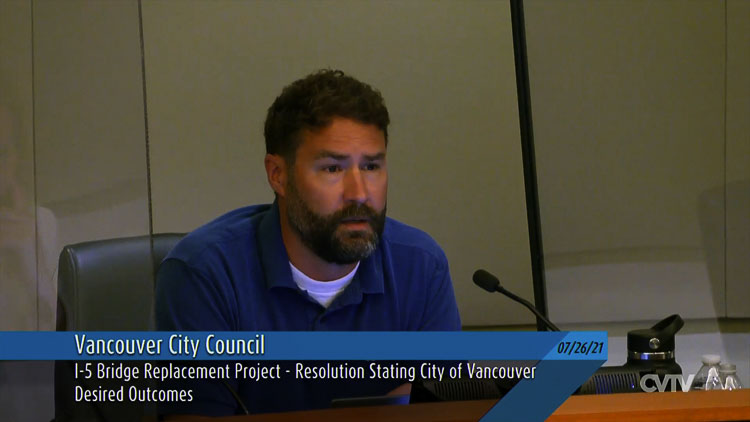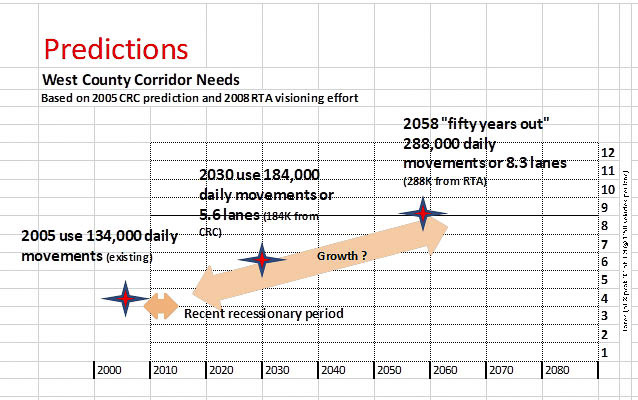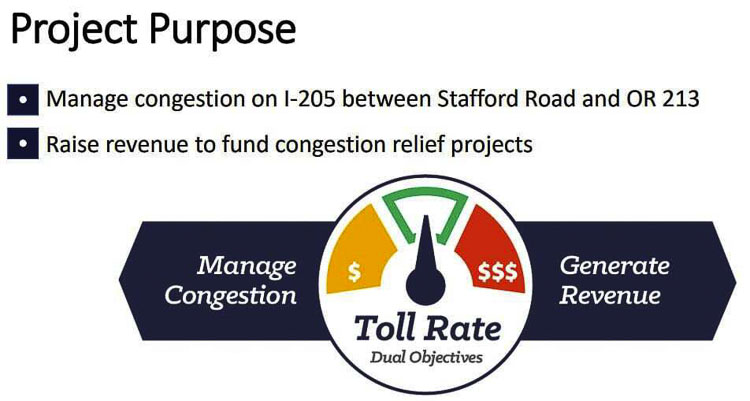Councilor Bart Hansen wants a 10-lane bridge, joins Councilor Sarah Fox in concerns about equitable tolling
For the third time in the past two months, members of the Vancouver City Council discussed the Interstate Bridge Replacement Program (IBRP), this time at their Monday meeting. The councilors ultimately passed a resolution calling for the bridge to be replaced, for there to be tolling to pay for the bridge, and more. While there is no specific bridge design yet proposed, they hope to influence the IBRP team.
Two weeks ago and a month ago the council discussed ideas for transit connections to downtown Vancouver, a preference for light rail that terminated at Clark College, and a lid over I-5 at Evergreen, and connections to the waterfront.
Councilors Bart Hansen and Sarah Fox expressed the most concerns about what was and wasn’t specified in the resolution. Hansen was concerned that the congestion pricing form of tolling could be seen as “roads for the rich” who could afford the tolls. He believed the poor couldn’t afford the tolls and therefore wouldn’t benefit from any improvements.

Hansen is looking for a 10-lane bridge. “An eight-lane bridge is a problem for me,” he said. “I don’t think we’re solving much in congestion, if we build an eight-lane bridge.”
Transportation architect Kevin Peterson had studied all the traffic projection data during the Columbia River Crossing (CRC) debate. He identified the need for five lanes in each direction by 2030, and eight lanes in each direction by 2060. Hansen would welcome seeing updated traffic numbers.
Fox was concerned about equity and fairness issues. There is no specific language reflecting her concerns that the poor couldn’t afford the tolls, nor was it reasonable for the single mom to use transit in lieu of paying the tolls.
“We really need to think about all of those jobs that don’t have as much choice when it comes to changing the time of day that they travel,” she said. Fox was concerned about the large portion of the population that is below median income not being able to afford tolls.
Staff member Katherine Kelly responded by mentioning the IBRP has an Equity Advisory Group (EAG) addressing those equity issues. Fox responded saying the council members should express their concerns now, rather than regret not speaking up later.
Fox shared that she believed transit doesn’t work for single parents needing to make several drop offs for children at school or daycare, and then go to their jobs. “That doesn’t usually translate very well into hopping on a bus. Otherwise, you’re going to need to take three buses, it’s going to take you an hour and a half to get to work, where someone without children and many stops, will be able to do that same trip in 20 minutes,” she said.
Ty Stober wanted to insure it was a replacement bridge. He also objected to having a specific number of lanes mentioned.
No traffic congestion relief
“I’m not seeing a project that relieves congestion,” said Hansen, who is afraid the project could end up with fewer than 10 lanes, acknowledging that the top priority for average citizens is congestion relief. Hansen was afraid if it wasn’t specified that the project contain at least 10 lanes, it could end up with an eight-lane bridge being proposed.
Hansen spoke about the previous Columbia River Crossing (CRC) proposal and the traffic data that led to the creation of the CRC. “Were they wrong on (the data for) a $3 billion dollar project,” he asked. “If things have changed so drastically since then, we should be looking for a different type of outcome.” Otherwise, he believes at least the same number of total lanes should be added.

Hansen spoke about the significant challenges of the traffic entering and exiting the freeway in the short distance of the bridge. Hansen pushed for two or three auxiliary lanes to handle that merging and exiting traffic.
Hansen would welcome seeing current data regarding bridge traffic and future traffic projection numbers. He acknowledges Vancouver and Clark County are growing and he only expects more vehicles to be on the road. He supports high capacity transit, but believes that’s not going to handle all the coming growth.
Stober pushed back, not wanting to specify any particular number of lanes. “I just want to push back slightly on something in that there are people who believed it should have been a 12-lane bridge, and who believed that a 10-lane bridge was wrong,” he said.
“I highly doubt we’re going to get to anything less than 10 lanes,” he said. “But we also may come to going back to 12 lanes. I don’t think there would be support on the south side of the river.”
“We want to maintain those three (through lanes), is that a policy objective,” Stober asked.
Hansen was clearly focused on relieving traffic congestion. He mentioned the possibility of six through lanes, with two of the lanes used for HOV traffic and for bus rapid transit. “What I don’t want to do is, I don’t want to under-build the bridge,” he said.
The final language adopted in the resolution read as follows.
“Retain three through travel lanes on Interstate 5 in the Bridge Influence Area and, based on updated analyses, accompanying auxiliary lanes to support the Program’s Purpose and Need.”
Congestion mitigation can take many possible forms, including ways to force people off the road. Congestion pricing could make crossing the bridge prohibitively expensive. Hansen was concerned that people really don’t understand what that means, and is concerned that the council supports improvements that improve traffic congestion.

Paying multiple tolls was another concern of Hansen. “When you explain to folks you can pay a toll to go over the bridge, and then when you cross to the other side, you will pay into congestion mitigation,” he said. “Well, hold on. You mean, I’m not just gonna get charged for crossing the bridge? No, that’s just the beginning.”
Hansen expressed concern that there was no language supporting C-TRAN. Additionally, Hansen was concerned that Oregon could control the tolls and the money, with Clark County having little to no say on how it is spent.
Hansen is okay with the idea that tolling helps pay for the bridge, but then needs to go away once the bridge is paid for. Congestion mitigation could mean perpetual tolls. He is concerned that tolling could be endless with money used for other purposes in the future.
The final vote by the Vancouver City Council was unanimous, with Councilor Laurie Lebowsky recusing herself because she works for WSDOT.




